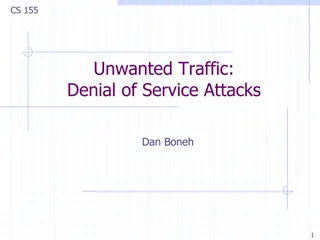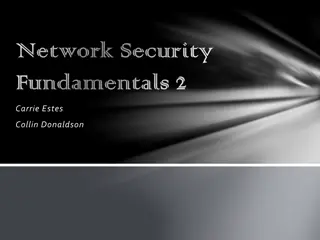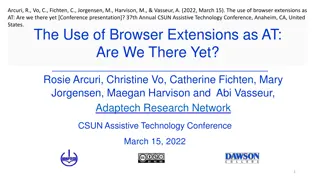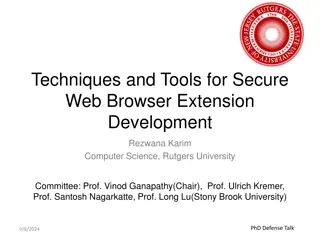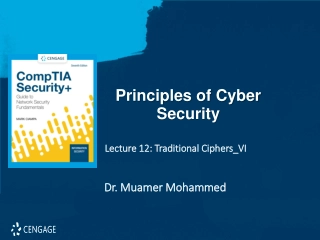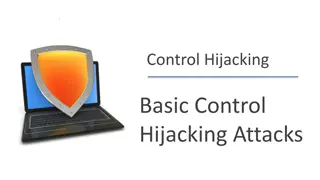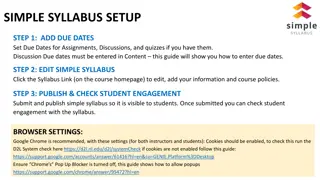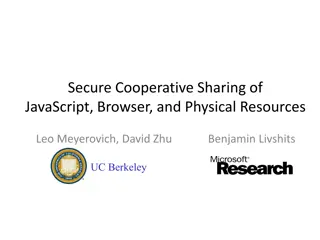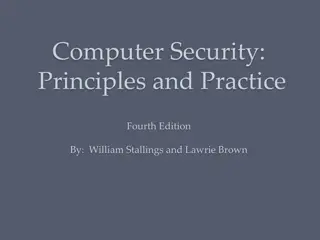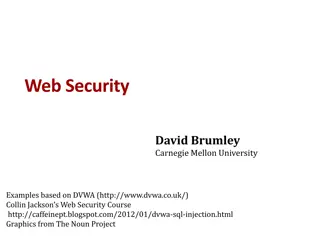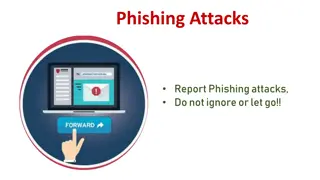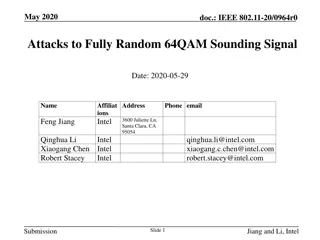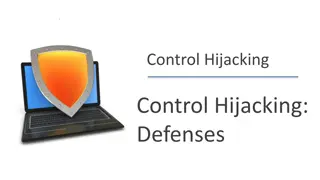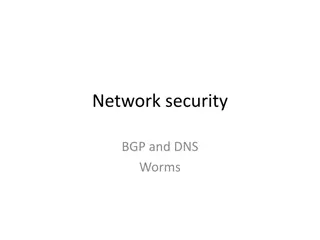Investigating Add-On Cross Site Scripting Attacks: Abusing Browser Address Bar
This presentation delves into the realm of add-on cross site scripting attacks, exploring real-world examples and effects on popular social media platforms like Facebook and Twitter. The experiments conducted shed light on malicious behaviors, deceptive techniques, and potential severe consequences beyond typical web vulnerabilities.
Download Presentation

Please find below an Image/Link to download the presentation.
The content on the website is provided AS IS for your information and personal use only. It may not be sold, licensed, or shared on other websites without obtaining consent from the author. Download presentation by click this link. If you encounter any issues during the download, it is possible that the publisher has removed the file from their server.
E N D
Presentation Transcript
ABUSING BROWSER ADDRESS BAR FOR FUN AND PROFIT - AN EMPIRICAL INVESTIGATION OF ADD-ON CROSS SITE SCRIPTING ATTACKS Presenter: Jialong Zhang
Roadmap Introduction Background and Motivation Experiments Discussion Related Work Conclusion
Introduction Add-on Cross Site Scripting (XSS) Attacks A sentence using social engineering techniques Javascript:codes For Example, on April 25, 2013, over 70,000 people have been affected by one such Add-on XSS attack on tieba.baidu.com.
Roadmap Introduction Background and Motivation Experiments Discussion Related Work Conclusion
Roadmap Introduction Background and Motivation Experiments Discussion Related Work Conclusion
Expriments Experiment One: Measuring Real-world Attacks Experiment Two: User Study Using Amazon Mechanical Turks Experiment Three: A Fake Facebook Account Test
Experiment One Data Set: Facebook: 187 million wall posts generated by roughly 3.5 million users Twitter: 485,721 Twitter accounts with 14,401,157 tweets Mischievous Tricks Keep popping up windows Alert some words Benign Behavior Zooming images Letting images fly Discussion among technicians Total Category Description # of distinct samples 40 3 2 1 2 4 4 2 58 Category Description # of distinct samples 2 5 1 1 Malicious Behavior Redirecting to malicious sites Redirecting to malicious videos Sending invitations to friends Including malicious JavaScript Changing Background Color Altering Textbox Color Malicious Behavior Redirecting to malicious sites Results Facebook Twitter Total Benign Behavior 9
Experiment One Discussion Beyond Attacks in the Wild: More Severe Damages Stealing confidential information Session fixation attacks Browser Address Bar Worms More Technique to Increase Compromising Rate Trojan Combining with Normal Functionality Obfuscating JavaScript Code So we have experiment two.
Roadmap Introduction Background and Motivation Experiments Experiment One Experiment Two Experiment Three Discussion Related Work Conclusion
Experiment Two Methodology Survey format Consent form Demographic survey Survey questions Comparative survey changing one parameter but fixing others Question sequence randomization Platform: Amazon Mechanical Turk
Experiment Two Results Percentage of Deceived People According to Different Factors Percentage of Deceived People According to Age Percentage of Deceived People According to Different Spamming Categories Percentage of Deceived People According to Programming Experiences Percentage of Deceived People According to Years of Using Computers and then Pasting Contents Factor Obfuscated URL Lengthy JavaScript Combining with Benign Behavior Typing JavaScript: Without the factor 29.4% 38.4% 37.1% With the factor 38.4% 40.4% 40.0% 38.2% 20.3%
Experiment Two Results Percentage of Deceived People According to Age Percentage of Deceived People According to Different Spamming Categories Percentage of Deceived People According to Programming Experiences Percentage of Deceived People According to Years of Using Computers Age > 40 Age Age <= 24 25 < Age <= 30 30 < Age <= 40 Rate 45.7% 39.8% 34.4% 14.0%
Experiment Two Results Percentage of Deceived People According to Different Spamming Categories Percentage of Deceived People According to Programming Experiences Percentage of Deceived People According to Years of Using Computers Family issue (like a wedding photo) Free ticket Category Magic (like flying images) Porn (like sexy girl) Rate 38.4% 36.3% 52.7% 29.2%
Experiment Two Results Percentage of Deceived People According to Programming Experiences Percentage of Deceived People According to Years of Using Computers No 38.4% Yes, but only a few times 36.3% Yes 52.7% Programming Experience Rate
Experiment Two Results Percentage of Deceived People According to Years of Using Computers Years of Using Computers < 5 years 5 10 years 10 15 years Rate 56.7% 41.1% 28.0% 15 20 years 24.3%
Roadmap Introduction Background and Motivation Experiments Experiment One Experiment Two Experiment Three Discussion Related Work Conclusion
Experiment Three Experiment setup A fake female account on Facebook using a university email address. By sending random invitations, the account gains 123 valid friends. Experiment Execution We post an add-on XSS sample. Description: a wedding photo JavaScript: show a wedding photo and send an request to a university web server Result 4.9% deception rate.
Experiment Three Comparing with experiment two why is the rate much lower than the one in experiment two? Not everyone has seen the status message. The account is fake and thus no one knows this person.
Roadmap Introduction Background and Motivation Experiments Discussion Related Work Conclusion
Discussion The motives of the participants We state in the beginning that we will pay those participants no matter what their answers are. Can we just disable address bar JavaScript? There are some benign usages. Ethics issue No participant is actually being attacked. We inform the participants after our survey.
Roadmap Introduction Background and Motivation Experiments Discussion Related Work Conclusion
Related Work Human Censorship Slow Disabling Address Bar JavaScript Dis-function of existing programs Removing the keyword JavaScript Problem still exists (a user can input himself) Defense on OSN Spam High False Negative Rate
Roadmap Introduction Background and Motivation Experiments Discussion Related Work Conclusion
Conclusion Add-on XSS combines social engineering and cross- site scripting. We perform three experiments: Real-world Experiment Experiment using Amazon Mechanical Turks Fake Facebook Account Experiment Researchers and browser vendors should take actions to fight against add-on XSS attacks.
Thanks! Questions?




